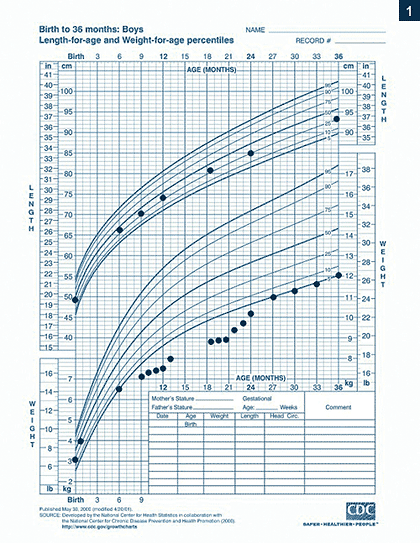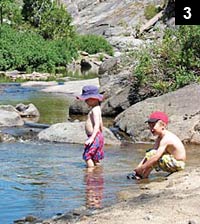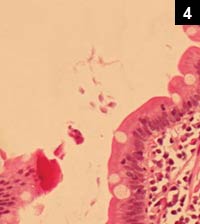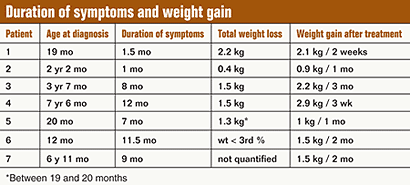A 20-month-old boy with failure to thrive
The following case was written by Mikla N. Derlet, MD, and John Belko, MD. At the time this case was presented, Dr. Derlet was with the Tuolumne Rural Indian Health Clinic, in Tuolumne City, Calif., part of the Indian Health Service of the Department of Health and Human Services. Dr. Belko was with the department of pediatrics, division of infectious diseases, at Kaiser South Sacramento, in California.
Dr. Derlet received her medical degree from the State University of New York in Brooklyn, where she stayed for her pediatric residency. Her first job was with the Indian Health Service in Tuolumne County in the Sierra Nevada foothills. She is now an associate physician in the department of pediatrics at the University of California, Davis.
![James H. Brien, DO [photo]](/~/media/images/news/print/infectious-diseases-in-children/2006/10_october/brien2_70_90_36206.jpg)
Dr. Belko also obtained his MD at the State University of New York, but then performed his pediatric residency at Mount Sinai Medical Center in New York. He subsequently completed a pediatric infectious diseases fellowship at the Children’s Hospital in Boston.
Case
![Mikla N. Derlet, MD [photo]](/~/media/images/news/print/infectious-diseases-in-children/2006/10_october/derlet_70_90_36206.jpg)
A 20-month-old boy presented to his primary physician with a history of failure to thrive. He was born full term at 3.1 kg and was breast-fed, with diet advanced to solids at appropriate times. Poor weight gain was first noticed around 9 months. At that time, a complete blood count (CBC) was normal, as were electrolytes, liver enzymes, and thyroid stimulating hormone. Stool cultures for bacteria were negative, and ova and parasites were not done. Feeding practices were reviewed, and the home environment was assessed. At 12 months, the child’s diet was supplemented with PediaSure, due to continued poor growth. He experienced a slight, but transient improvement in growth rate (Figure 1). Consequently, he was referred to the Tuolumne Rural Indian Health Clinic where he was also evaluated by a pediatric outreach gastroenterologist.
![John Belko, MD [photo]](/~/media/images/news/print/infectious-diseases-in-children/2006/10_october/belko_70_90_36206.jpg)
By history, the child was an active boy, and except for an aversion to milk, he had a good appetite and enjoyed all table foods. As noted, his diet was now supplemented with three cans of PediaSure per day, which should have provided adequate calories for growth. There was no history of vomiting or diarrhea. He passed two to three large stools per day, which smelled quite badly. He did not attend day care and the family had no pets. His parents were non-consanguineous and of northern European ancestry. The father was 5’6” with a medium-build, and the mother was 5’4” and slender. He had a 10-year-old healthy brother who was growing properly. However, his brother had been treated for a Giardia infection several years ago. The family lived in a rural community in western United States and used municipal water for drinking. During the summertime, the family camped along mountain streams while panning for gold, a popular pastime for many residents in the area.
Examination revealed a well-appearing 20-month-old male with normal vital signs, a weight of 8.9 kg (significantly below the 5th percentile) and a height of 82 cm (25th percentile). His physical examination revealed a small, but adequately nourished child, with clear lungs, no cardiac murmurs, a soft, mildly protuberant abdomen without masses nor organomegaly, normal bowel sounds, and no cutaneous lesions. Laboratory tests revealed a normal CBC, erythrocyte sedimentation rate (ESR), electrolytes, calcium, phosphorus, alanine aminotransferase, total protein, albumin, quantitative immunoglobulins, negative gliadin Ab, endomysial Ab, tissue transglutaminase Ab, and a normal urinalysis. A stool Giardia antigen test returned positive.

What’s Your Diagnosis?
- Inflammatory bowel disease
- Celiac disease
- Giardiasis
- Salmonellosis
Answer
You may have thought we were trying to trick you with the positive Giardia antigen test, but the answer turned out to be giardiasis, which is the most prevalent parasitic illness in the developed world.
Giardia intestinalis (formerly known as G. lamblia) is a non-invasive flagellate protozoan that lives in the small intestine of its host. It has two lifecycle stages: trophozoite (figure 2, from the Jim Bass collection) and the infective cyst, which can be acquired from water, food or direct fecal-oral contact. Humans are the host and reservoir, but the parasite is also ubiquitous in pets, livestock and wildlife.
The clinical consequences of giardiasis are highly variable and depend on host factors (age, nutritional status, and immunological status) and the genotypic differences between assemblages of G. intestinalis. The most frequent outcome is a self-limited and asymptomatic infestation. Acute illness is characterized by loose bowels, abdominal discomfort, bloating and weight loss. In the United States, most of the symptomatic infections are waterborne and acquired during the summer months. The highest number of reported cases is in children aged 1 to 5 years.



Our patient likely became infected from cyst-contaminated water while camping. Many mountain streams have water that appears clear and clean (figure 3), but may be heavily contaminated with Giardia cysts, especially those with beavers upstream. The patient failed to clear the parasite and progressed to chronic giardiasis with the predominant symptoms of malabsorption and failure to thrive (FTT).
We found three articles relevant to our experience. In 1973, Carswell et al. examined 93 patients with clinically suspected celiac disease. Among the multiple final diagnoses, 58 (62%) of the children had biopsy proven celiac disease and 12 (13%) had giardiasis. Other prominent diagnoses were psychosocial deprivation (9), idiopathic FTT (7), cystic fibrosis (3), familiar short stature (3), and small-for-gestational-age (3). In 1975, Burke published a case series of seven children with giardiasis and poor growth or weight loss. All children demonstrated “catch-up” weight gain after treatment with metronidazole (see table). The mean duration of symptoms prior to diagnosis was 7 months. Giardia cysts were found in stool samples from two children. In the rest, multiple microscopic examinations of the stool were negative. Giardia was eventually demonstrated in duodenal aspirates as shown in figure 4, a duodenal biopsy of a child with giardiasis (courtesy of John Pohl, MD, a Scott & White Pediatric Gastroenterologist). Lastly, in a retrospective study of 956 hospitalizations for giardiasis in Michigan between 1983-1987, 18.7% of children younger than 5 years had a concurrent diagnosis of failure-to-thrive.

Other studies have examined the relationship between asymptomatic giardiasis and growth. An early study by Brown in London demonstrated Giardia cysts in the stool of 37 (27%) of the 139 children examined on admission to the Ladywell nursery. No difference was observed in mean height and weight measurements between the infected and uninfected children. In an 18-month longitudinal study in Houston daycare centers, 27 (33%) of 82 children had Giardia cysts in their stool at least once, and 12 excreted cysts for a mean of six months. Again, no relationship was observed between height and weight and Giardia infestation. In another longitudinal study of 89 children in day care in Israel, 33 (37%) had Giardia cysts in their stool and no detrimental effect on growth was demonstrated. However, recent reports from the developing world have implicated chronic giardiasis in wasting (decreased weight-to-age), stunting (decreased height-to-age), and wasting with stunting.
In conclusion, one must always consider Giardia as a potential cause for failure to thrive, particularly in children who live in or frequently visit rural areas. These areas pose an additional risk for acquiring giardiasis because of contact with domestic animals, prevalence of multi-pet families, popularity of fresh water swimming, exposure to camping associated unsanitary conditions and access to untreated drinking water.
Regarding the other choices, celiac disease could present in a similar fashion, but the negative gliadin Ab, endomysial Ab, tissue transglutaminase Ab helped rule out celiac disease. Inflammatory bowel disease could also present with a failure to thrive pattern, but the ESR would likely be elevated. Lastly, the negative stool cultures make salmonellosis unlikely. Giardiasis can be identified by the cysts or trophozoites in the stool or biopsy specimen, but a stool antigen test is gaining popularity because of its high sensitivity and specificity. Once the diagnosis was made, treatment was initiated with metronidazole 15mg/kg/day TID for 7 days. Other potential treatment choices include nitazoxanide for 3 days or tinidazole as a single dose. Consult the Red Book for doses and other potential choices.
The patient’s family members subsequently tested negative for Giardia. On follow-up testing no Giardia cysts were seen in the child’s stool (x3). Three months after treatment he had gained 1.2 kg and by six months his weight reached the 5th percentile (Figure 1). His frequent, bulky stools also resolved. On follow-up to date he continues to follow a normal growth curve.
Commentary
Giardia was first seen by the “father of microbiology,” Anton von Leeuwenhoek (1632-1723), as he was examining his own diarrheal stool in 1681. The organism was initially named Lamblia intestinalis in the late 19th century after the bohemian physician, Vilem Dusan Lambl (1824-1895), and later changed to recognize the extensive work of the French biologist, Alfred Giard (1846-1908). At least for now, the organism is named Giardia intestinalis. Who says there’s no humor in medicine?
Remember, set the example and take your influenza vaccine.
Lastly, remember our fallen military men and women, and those still serving, and regardless of your political affiliation, don’t forget to vote.
For more information:
- Thompson RCA. The zoonotic significance and molecular epidemiology of Giardia and giardiasis. Veterinary Parasitology. 2004;126:15-35.
- Hlavsa MC, Watson JC, Beach MJ: Giardiasis Surveillance – United States, 1998-2002. CDC Surveillance Summaries. 2005;54:9-16.
- Haque R, Roy S Kabir M et al. Giardia assemblage A infection and diarrhea in Bangladesh. J Infect Dis. 2005;192:2171-2173.
- Carswell F, Gibson AAM, McAllister TA. Giardiasis and celiac disease. Arch Dis Childhood. 1973;48:414-418.
- Lopez CE, Dykes AC, Juranek DD et al. Waterborne giardiasis: a communitywide outbreak of disease and high rate of asymptomatic infection. Amer J Epidemiol. 1980;12:495-507.
- Burke JA. Giardiasis in childhood. Amer J Dis Children. 1975;129:1304–1310.
- Lengerich EJ, Addis DG, Juranek DD. Severe giardiasis in the United States. Clin Infect Dis. 1994;18:760-763.
- Brown EH. Giardia Lamblia: The incidence and results of infestations of children in residential nurseries. Arch Dis Childhood. 1948;23:119-128.
- Pickering LK, Woodward WE, DuPont HL, et al. Occurrence of Giardia Lamblia in children in day care centers. J Pediatrics. 1984;104:522-526.
- Ish-Horowitz, Korman SH, Shapiro M, et al. Asymptomatic giardiasis in children. Pediatr Infect Dis J. 1989;8:773-779
- Fraser D, Bilenko N, Deckelbaum RJ, et al. Giardia lamblia carriage in Israeli Bedouin infants: risk factors and consequences. Clin Infect Dis. 2000;30:419-424
- Hesham Al-Mekhlafi MS, Azlin M, Nor Aini U, et al. Giardiasis as a predictor of childhood malnutrition in Orang Asli children in Malaysia. Transactions of the Royal Society of Tropical Medicine and Hygiene. 2005;99:686-691.
- Sackey ME, Weigel MM, Armijos RX. Predictors and nutritional consequences of intestinal parasitic infections in rural Ecuadorian children. J Tropical Pediatr. 2003;49:17-23.
- Newman RD, Moore SR, Lima AAM, et al. A longitudinal study of Giardia lamblia infection in north-east Brazilian children. Tropical Medicine and International Health. 2001;6:624-634.
- Prado MS, Cairncross S, Strina A, et al. Asymptomatic giardiasis and growth in young children; a longitudinal study in Salvador, Brazil. Parasitology. 2005;131:152-156.
- James H. Brien, DO, Pediatric Infectious Disease, Scott and White’s Children’s Health Center and Associate Professor of Pediatrics, Texas A&M University, College of Medicine, Temple, Texas; Mikla N. Derlet, MD, Associate Physician, Department of Pediatrics, University of California, Davis; and John Belko, MD, Pediatric Infectious Disease Fellow, Children’s Hospital, Boston.
What’s Your Diagnosis? is a monthly case study featured in Infectious Diseases in Children, with treatment information and discussion to follow.
